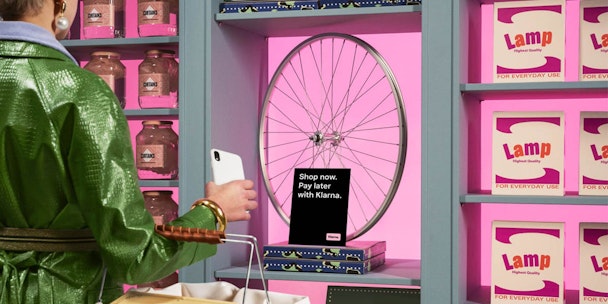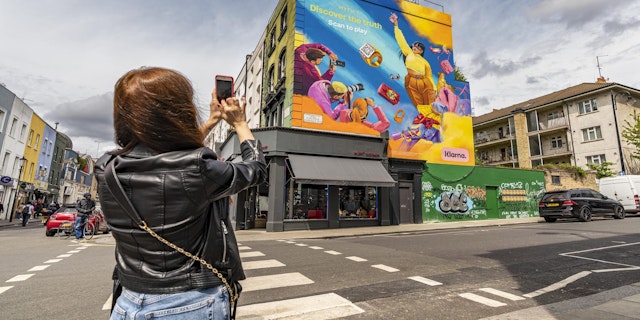How ‘buy now, pay later’ marketing is shaking up the finance sector
Blue, the color of trust, has long been the go-to hue of financial marketing. That was until Klarna showed up with its millennial pink and Snoop Dogg in tow, looking to dismantle the sector. As part of The Drum’s latest Deep Dive, Marketing Secrets of Fast-Growth Brands, we take a look at the (sometimes controversial) tactics used in the finance space.

Buy Now, Pay Later on building trust through branding
The ’buy now, pay later’ (BNPL) sector has grown exponentially these past few years, accelerated by the pandemic’s squeeze on consumers’ purses and continued migration to shopping online. Klarna is the best-known, but since it set up shop there has also been brands such as AfterPay and its offshoot ClearPay joining the market, followed by the likes of Layby and Affirm, as well as legacy fintech PayPal updating its product to offer BNPL.
Market leader Klarna is governed by the idea that the old banking system is broken, and that it is here to challenge the status quo. “The old blue that used to mean ’trusted’ but the sector hasn’t kept up with the times and now it stands for lack of mobility,” says AJ Coyne, its head of global brand and creative. “We believe in being a pink savor in a sea of boring blue.”
At creative agency Cult, which works with ClearPay, client partner Owen Rowbotham says the success of BNPL marketing has been a result of the constraints it operates in, and that a lack of trust around BNPL has “forced brands to be much louder about what they do”.
Rowbotham’s colleague Emma Greenway, who is Cult’s head of European accounts, adds that regulation is driving the BNPL marketing strategies. “The brands are quite stifled from all of the big social channels – they can’t use influencers, for example, which pushes them to be disruptive and be different. The huge handcuffing that is happening means they have to be extra creative.”
This, according to Rowbotham, has meant BNPL brands using “old school marketing tactics,” excelling instead at experiential activations and events that bypass a lot of regulation.
Out-of-home has been an important channel and Klarna won three prizes at The Drum Awards for Out Of Home 2021.

Building consumer connections
Kelly Gillease, chief marketing officer at the personal finance firm NerdWallet, says brand building is vital to the financial services newcomers. “Understanding and comparing the differences between specific financial products can be challenging given the complexity of many of these products, but connecting with brands is easier,” she says.
According to Gillease, fintech is the newest industry to really focus on brand and its success is marked by its ability to “provide consumers with information on products and services that they didn’t know they needed”.
At NerdWallet, Gillease says it’s important to “show up in the places and spaces where consumers might have money questions”. She gives the example of sponsoring a home renovation show that might spur thoughts about refinancing. She adds that for fintech brands, “partnerships are also a major source of acquiring consumers” and suggests tying with retailers to be visible at the checkout.
What next for BNPL?
Coyne’s latest strategic priority is to tell consumers that Klarna has moved beyond BNPL. “The key challenge for us to solve in marketing is to help the world realize we aren’t just BNPL and that, actually, the Klarna story is way beyond payments,” he says. “Klarna is here to disrupt and revolutionize the way people shop, bank, and pay.”
To meet this aim, Klarna has acquired the search tool firm Price Runner – which enables customers to find the cheapest retailer – as well as the automatic discount company Piggy.
According to Coyne, competition from a “slew of copycat products and offerings” trying to replicate its brand has kept Klarna on its toes. “It’s made us constantly stress test and look for ways to challenge ourselves and drive change in the category.”
Traditional banks take note
For Dionysis Livanis, a creative director at Definition-owned branding agency Redhouse, the rise of BNPL is forcing traditional banks to update their brands and systems in order to compete with the challengers. HSBC has been on top of this trend, pushing out its bright red color palette in eye-catching OOH campaigns.
“Traditional banks like HSBC, Barclays and Lloyds will need to update their brands and their systems to be able not just to compete with the challengers but to adapt to a changing banking landscape and to their customers’ new habits and expectations,” he says.
Livanis likens the landscape to when British Airways launched budget airline Go off the back of EasyJet challenging the aviation model. If banks don’t adapt to the new reality, he says, they risk losing more customers and be seen as irrelevant. “The brands that do that sooner rather than later will be the ones to gain the most.”
For more Marketing Secrets of Fast-Growth Brands, check out The Drum’s latest Deep Dive.

